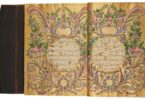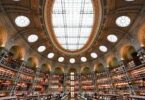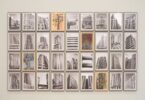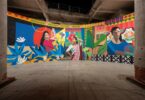Razmig Bedirian
The Malwiya minaret of Samarra was a familiar site for Walid Siti during his bus travels between Iraqi Kurdistan and the Institute of Fine Arts in Baghdad, from which he graduated in 1976.
A spiralling conical tower of ochre hues, the minaret is a looming remnant of the mosque that was built in the 9th century. The Great Mosque of Samarra, commissioned by the Abbasid caliph Al-Mutawakkil, was the world’s largest in its time. Today, only its outer wall and minaret remain.
The minaret had a lasting impression on Siti, growing stronger in his memory after he left Iraq in the 1980s. Escaping Baathist persecution, he travelled to the former Yugoslavia and eventually settled in London. To the artist in exile, who kept watch on the region’s shifting political developments from afar, the landmark became a symbol of power – or rather, its precarious nature and fragility.
:quality(70)/cloudfront-eu-central-1.images.arcpublishing.com/thenational/XAY6OGYJFREPTLBNNYYY2OGLFM.jpg)
The Malwiya minaret has a starring role in Siti’s oeuvre and is a centrepiece at Fragile Construct, his new solo exhibition at Dubai’s Meem Gallery, which runs until February 3.
“The tower has been a point of inspiration for me since I was a student in Baghdad in the 1970s,” Siti tells The National. “When I was abroad in the diaspora I became more and more fascinated and intrigued by it.”
Rather than presenting the tower with a faithful depiction, Siti instead aims to reveal its metaphorical essence. His earlier ink drawings feature its spiralling exterior as a wilting mass. Other studies, meanwhile, bring the minaret to form with criss-crossing lines and ladderlike shapes.
Siti built upon this approach with his monumental paintings. Expressive and vivid with motion, the looming structures in his works have a vulnerable quality, as if they were on the verge of unravelling at the seams.
While Siti uses the minaret to address constructs of power, the artist also considers the remarkability of its construction and design, praising its mysterious architect. A video artwork plainly touches on this with its title: To the Unknown Architect.
The piece is significant because it also marks the time when Siti finally scaled the tower. Though he had seen the monument countless times in his youth, he only had the chance to climb it in 2019. The experience, he says, was “overwhelming and incredible”.
“When I had the chance to go back to Samarra, I climbed it and photographed it and somebody helped with the drone [footage] as well,” he says.
“The tower is on a flat land and is seen from everywhere. The beauty of it, the aesthetic … It has so many connotations and ideas. Climbing from a wider circle and as you go up, the circle gets slowly smaller. For people, this is reminiscent of the Tower of Babel. It’s been an inspiration for artists and architects all over the world.”
:quality(70)/cloudfront-eu-central-1.images.arcpublishing.com/thenational/RRAEAAJAWNCCJIKARUFZS653VI.jpg)
The Malwiya minaret is not the only towering form that Siti refers to in his work. In his 2023 painting Homage to Rifat Al Chadirji, the artist pays tribute to the Iraqi-Turkmen architect by portraying his design for the now non-existent National Insurance Company in Mosul.
The work depicts the tower with upright splendour, using bold vertical lines that are unmistakably Siti’s. Again, the painting is replete with dynamism, but gives a sense of abandonment, particularly around its topmost section. This aesthetic take reflects upon the tower’s tragic and belligerent fate.
“The National Insurance Company was built in the 1960s,” Siti says. “ISIS used the top part as a platform for their snipers. Then they started throwing people from there. People they deemed degenerate. It became very notorious. It was badly damaged during the war. People in Mosul debated whether to keep it or demolish it. They demolished it in the end. For me, it epitomises this cycle of construction and destruction.”
:quality(70)/cloudfront-eu-central-1.images.arcpublishing.com/thenational/ZNIKC5AELNFBTETTJTMHNRLN24.jpg)
The tower’s transformation from a place of economic power to an instrument of war and torture before its obliteration sustains Siti’s studies of power within lofty architecture.
The artist brings these studies to three dimensions with his sculptures. The works comprise towers erected using scraps of wood huddled together, giving the impression that their form might topple over at the slightest touch.
One of the sculptures, Collective Dream, was created using ladderlike forms piled together to a pointed top. The work reflects on the communal effort required to achieve a goal, with the ladder used to depict the idiom of climbing towards success. However, as some rungs seem to obstruct others, the work also hints at how individual success may come at the cost of another’s.
:quality(70)/cloudfront-eu-central-1.images.arcpublishing.com/thenational/YYTF5AWCEJC7PAVW46GQTTS5M4.jpg)
Besides the fragility of power, Siti’s art also touches upon aspects of Kurdish identity. His White Mountains painting, created in 2019, is a triptych that portrays the snow-capped peaks of Iraqi Kurdistan. The mountains have a significant place within Kurdish culture.
“It is a place of refuge, a source of water, trees and fruit,” he says. “A whole livelihood for Kurdish people. I tried to portray the mountains as a habitat for the Kurds.”
The mountain range within the painting is anything but stationary. The vertical lines superimposed on the curving strokes give the mountains a tempestuous character, overtaken by rain and snow. White Peaks, on the other hand, which was painted this year, depicts the cluster of mountains with an assemblage of lines that has become idiosyncratic of Siti’s hand. The lines, painted with an arctic white emanate brightly against the subdued, decidedly gloomy backdrop.
While the two paintings are tributes to the sanctuary the peaks offered the Kurds during years of persecution, Siti also shows how they, like the towers he addresses, were used as a symbol of power. He addresses this quality in his video artwork The Troubled Bear and the Palace.
:quality(70)/cloudfront-eu-central-1.images.arcpublishing.com/thenational/YQDGQSVO7ZB2PI7NUREHR5KDPE.jpg)
A compilation of archival material and footage shot by Siti, the work shows a group of Kurds ceremoniously releasing three bears at one of the palaces Saddam Hussein erected on the Kurdish mountains. The palaces were arguably a way for Hussein to claim dominion over an area that geographically was of utmost importance to Kurdish identity and survival.
Hussein was infamous for his persecution of Kurds, even using chemical weapons against the Kurdish village of Halabja in 1988, killing thousands.
“The bears were released at the helipad where Saddam used to land,” Siti says. “This region is known for being a habitat for bears because there are many caves there.” The Troubled Bear and the Palace also alludes to passages from the ancient epic of Gilgamish, drawing parallels with the king’s quest for immortality with Hussein’s own quest for power.
“He built the palaces to stamp his legacy on the Earth forever,” he says. “Gilgamish came back humbled, to live and die as anybody else. Saddam as well, in the end, metaphorically did the same. He had to accept his fate.”
“With the palaces and the bears, I felt that it summarises what happened to Iraq as a whole and to the Kurds in particular.”
Courtesy: thenationalnews







